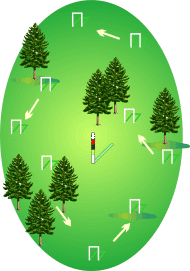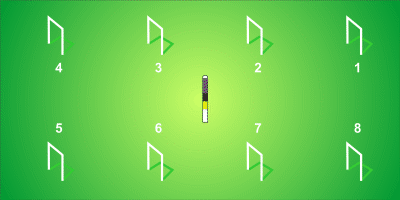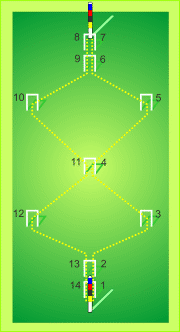
|
|
THE OFFICIAL TOEQUET RULEBOOK |
|
Golf Croquet Rules For Toequet and Malletball
For 2, 3, or 4 players; game time approximately 30 minutes; quickly learned and suitable for novice group events and competitions as well as casual family or social play.
These rules are very similar to the rules for world championship Golf Croquet, with only slight variations: (1) instead of croquet balls, the balls are soccer balls, with oversized wickets to match, made of break-away PVC piping for safety. (2) Instead of striking the balls with a mallet (Malletball) you may choose instead to kick the balls (Toequet.)
THE COURSE: For Xtreme Malletball, you make up your own course, putting the wickets wherever your pioneering spirit leads you – and there are no fixed boundaries; a roughly circular or oval course is recommended. The tamer games of Court Toequet and Court Malletball use any standard court configuration, either with six wickets or nine wickets. A court of any size may be laid out, but a clear area of at least 100 feet wide and 125 feet deep is recommended. An ideal six-wicket court is 150 feet wide by 180 feet long approximately; a good size for a proportional nine-wicket court is 100 feet wide by 200 feet long. Boundaries may be set according to “house rules.” If boundary lines are used, play must stop until out-of-bounds balls are replaced.
THE TEAMS: Blue/Green play against Red/Yellow in a two-sided game, with one or two players on each side. Each player may directly kick (or stroke) only his or her own ball in the order of play, but the player’s ball may impact other balls. In singles, one person plays both balls of the side in the proper sequence: Blue/Red/Green/Yellow. THE TURNS: Play is always in the sequence Blue/Red/Green/Yellow (the order of the colors on the stake and on the wickets). There is only one shot per turn. There are no bonus shots for scoring a wicket or striking another player’s ball with your own ball. STARTING THE GAME: The starting side is determined by a coin toss. The balls are played in proper sequence (Blue/Red/Green/Yellow) from the agreed-upon Starting Tee. This is the only tee-off in the entire game. All the other turns are played from where the balls lie. SCORING: Each wicket is scored by only one ball, which wins the point for its side. Wickets must be scored in the order and direction of the course. A ball must make a complete pass through the proper wicket from the correct side to score a point. Any number of turns may be taken to complete the pass through the proper wicket in the order of the course and thus score the point. After a wicket is scored by any ball, play continues in sequence from where the balls lie to contest the next wicket in the order of the course. THE HALF-WAY RULE: If at the beginning of a turn the player's ball is more than halfway to the next wicket in a position it achieved BEFORE the previous wicket was scored, the opponent may request that the player move the ball to any point within six feet of the last wicket to be scored, and the ball must be played from that position. WINNING THE GAME: “House rules” determine how many points must be earned to win the game; a four-point win is sufficient; if you want a longer game, you may repeat the course any number of times, playing continuously until the winning score is reached.
|
| |
||
TOPGUN TOEQUET & TOPGUN MALLETBALL
A fast-action, high-energy target-shooting competition for doubles teams; recommended as a one-touch teamwork drill for soccer; works well with any athletically conditioned group; approximately three minutes per round.
This contest is a race around the course to the peg for two doubles teams starting at the Center Stake in the middle of an eight-wicket (or larger) course. The course can be laid out in two identical rows of four wickets each, up to 20 yards apart, with the two rows separated by up to 20 yards and the stake in the center of the course.
All players start from within two yards of the center stake. Both teams start simultaneously at the starting signal. Both teams run the course counter-clockwise. One team runs the course in the 1, 2, 3, 4, 5, 6, 7, 8 sequence and the other team runs the course in the 5, 6, 7, 8, 1, 2, 3, 4 sequence. The first team to hit the stake wins. In Topgun Toequet, the balls are struck with the feet: in Topgun Malletball, the balls are hit with mallets. In doubles play the opening stroke is made by one team member, the second stroke must be made by the other team member, and play must alternate stricktly between the team members. One cautionary note: Be aware of the possibility of injury if mallets are used, and definitely don't use mallets for teams of more than two. Three and four-person teams: If you want to play with larger teams, allow extra time for the teams to practice coordinated moves, as Topgun with larger teams becomes a demanding, concentrated exercise in fast-action teamwork. If possible, expand the course to allow more space between the wickets. In One-Touch Topgun for three or four persons on a team, strict rotation is not required, but no player may touch the ball twice in succession. Topgun Massacre - If one team catches up to the other team (determined by having the same target wicket) the fast team is immediately declared the winner. Fouls & Penalties - In a tightly regulated competition, on-court referees stationed near the center stake may penalize offending teams for fouls or infractions of the rules by adding five seconds to the time of the offending player(s) for each foul committed. Disqualification - If a player touches the opponent team's ball the touching player's team is disqualified; disqualification also occurs if a player or team skips a wicket or plays the wickets out of order. These contests are typically very fast - no more than two or three minutes - so a soccer team or other sizeable group can play an elimination Topgun Tournament within a one-hour time span, including a quarter hour of practice and coaching. Allowing a liberal three minutes per round and using only one equipment set, an elimination tournament for 32 players (or 16 doubles teams) requires only 45 minutes for the 15 three-minute rounds. |
| |
|
BACKYARD CROQUET RULES
Game time of one to two hours; recommended for small, casual gatherings of family and friends; difficult to manage for large group competitions and not recommended for competitive events until you have lots of time and a large stock of equipment to run many games simultaneously.
The game can be played by 2, 3 or 4 players. Toequet is played by kicking the ball; in MalletBall, all the shots are taken with the mallet. The players may agree for any reason to have a “mixed” game in which, for example, the adult uses the mallet, and the child kicks.
The court layout (seen right) can be set up in any grassy area from 75-150 feet wide by 150-300 feet long. Trees, slopes, and other obstacles only make the
The objective is to pass through wickets 1 to 7, hit the turning stake, and then pass through wickets 8 to 14 and hit the end stake with both your balls before your opponent(s). Boundaries should be agreed to before starting play. Out of bounds balls are replaced in bounds with no penalty. Turns are taken in the sequence Blue, Red, Green, Yellow. 2 players – One player plays the Blue and Green balls. The other player plays the Red and Yellow balls. The starting point or tee is midway between the end stake and wicket #1. A turn consists of one kick (or stroke with the mallet) plus any bonus kicks (or strokes) earned. One bonus shot is earned for passing through your target wicket (or hitting the turning stake). Two bonus shots are earned if two target wickets are scored in a single shot. Two bonus shots are earned for striking another ball. After earning the bonus shots from another ball you must pass through your target wicket (or hit the turning stake if that is your next point to be scored) before you can earn bonus shots from that ball again. (In the language of croquet, you are said to be “dead” on any ball you have struck since scoring your last wicket, and you may not hit it again to earn bonus strokes until you “clear” yourself by scoring your next wicket.) For the first of your two earned bonus shots, you have this choice: 1. Place your ball against the struck ball and hold your ball in place. Strike your ball and “send” the other ball while your own ball remains stationary. (There is no penalty if your ball happens to move.) 2. Place your ball against or as near as possible to the struck ball in any direction and strike your own ball, causing both balls to move in the calculated directions. 3. Place your ball away from the struck ball up to a distance of one step and strike your own ball without impacting the previously struck ball. Whichever of the three options you chose for the first bonus shot, you take your second shot from where your ball stopped after the first bonus shot. Bonus shots may not be accumulated. If both a target wicket is made and another ball is hit in a single shot only the first accomplished counts. If another player knocks your ball through your target wicket the wicket counts but no bonus shots are earned for your side. Once a ball has passed through wicket 14 but has not hit the end stake it is a Rover. Rovers can earn bonus shots from all the other balls in a turn, but may not hit the same ball twice in a turn. Disputes are resolved by the shooter, unless there is a designated referee for a shot in question. All local variations to these rules are permissible. PLAY THESE VARIATIONS OR MAKE UP YOUR OWN GAMES! GOLF TOEQUET AND GOLF MALLETBALL allow you to bring the golf course to your own big backyard or park. You design the course and establish par and let the games begin. No more lost balls, and the games can be played by one or more. One suggestion: Set each wicket open to your tee so a hole in one is always possible. CROQUET BOWLS is a good game for children irresistibly attracted to those big and brightly colored balls. Simply create a line and put up a stake some distance away, and instruct the children to kick or throw the ball to the stake from anywhere behind the line, following the rotation of the colors. The ball(s) closest to the stake at the end of the four-ball round wins the point(s), and the first team to ten points wins the game. |
| |
|
HOW TO ORGANIZE AND MANAGE GROUP EVENTS
These games work well for almost all groups because almost everyone can play them, on almost any outdoor surface. Toequet and Malletball with the Golf Croquet rules at the top of this page are ideal for social competitions and team-builders, because everyone begins, theoretically, at the same level, with little or no prior experience with the equipment or the game. You can make the course hard or easy. For an easy course, the wickets are set full-width and close together on flat ground with no obstacles. For a challenging game, the wickets are widely separated on a huge course with hills and obstacles - and the bottoms of the wickets are pinched towards the center to create a narrower opening for the balls.
At family gatherings, the children – especially the younger ones – will prefer to KICK the ball, because the mallets are too big for them; parents may even partner with youngsters, with the adults using mallets and the kids kicking the balls. To pacify the younger set (and allow the adults to play in peace) set up a few wickets for the kids that can be used simply as “target practice” in a contest to see who can kick the ball through the wicket from various distances. If you have the patience to teach the kids the color rotation, show them how to do match-play golf with the equipment. Or with some balls and a stake, have the kids play a kicking version of bowls. For social tournaments and team-builders, a “shotgun start” is recommended on a roughly circular course, allowing play to begin simultaneously at many points on the course. On a nine-wicket circular course, for example, put the stake in the middle, and have the players gather there to start all their games. Start a doubles game at every other wicket; with 16 balls, for example, you can start four games at each of four wickets; the faster teams will sometimes be asked to wait until their next wicket is cleared by the team ahead of them – just as on a golf course. Even in a casual social setting, a tournament adds spark and drama to your event and provides an exciting climax with solid spectator values. Organize a simple single-elimination doubles tournament, with winners playing winners after each round. (Losers can play losers after every round also, when there is space.) When the ladder becomes uneven, simply “promote” a worthy loser to fill it out in even numbers, until there are only two sides left for the final. Then make a really big deal out of the final, with play-by-play and “expert commentary” from the sidelines, culminating with the scoring of the winning point and the award of prizes. If you find you’re running out of time in an elimination tournament requiring four-point wins in Golf Croquet, simply switch to the fast-moving TOPGUN to play down the semi-finalists and finalists. You might want to do this anyway, as these action-packed two- minute contests make a crowd-pleasing, dramatic finish for your event. If you find you're running out of time in an elimination tournament requiring four-point wins in Golf Croquet, simply switch to the fast-moving TOPGUN to play down the semi-finalists and finalists. You might want to do this anyway, as these action-packed two- minute contests make a crowd-pleasing, dramatic finish for your event. |


 court more challenging.
court more challenging.